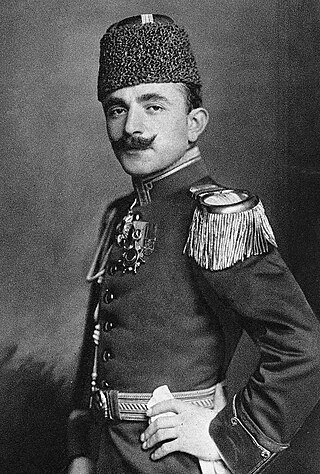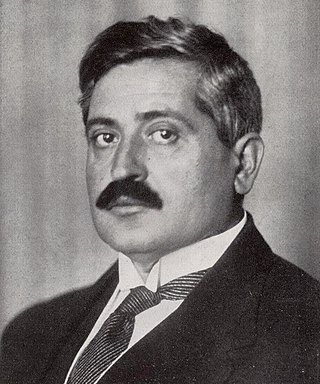
Young Turks was a political reform movement in the early 20th century that favored the replacement of the Ottoman Empire's absolute monarchy with a constitutional government. They led a rebellion against the absolute rule of Sultan Abdulhamid II in the 1908 Young Turk Revolution. With this revolution, the Young Turks helped to establish the Second Constitutional Era in the same year, ushering in an era of multi-party democracy for the first time in the country's history.

İsmail Enver, better known as Enver Pasha, was an Ottoman military officer, revolutionary, and convicted war criminal who formed one-third of the dictatorial triumvirate known as the "Three Pashas" in the Ottoman Empire.

Koca Sinan Pasha was an Albanian-born Ottoman Grand Vizier, military figure, and statesman. From 1580 until his death he served five times as Grand Vizier. In 1594, he ordered the burning of Saint Sava's remains on the Vračar plateau.

Mehmed Said Pasha, also known as Küçük Said Pasha or Şapur Çelebi or in his youth as Mabeyn Başkatibi Said Bey, was an Ottoman monarchist, senator, statesman and editor of the Turkish newspaper Jerid-i-Havadis. He served as grand vizier for nine years in total, seven times during the reign of Abdul Hamid II and twice during the Second Constitutional Monarchy. He was known for his opposition to the extension of foreign influence in the Ottoman Empire. He was among the statesmen who were disliked by the Committee of Union and Progress (CUP). However in his last two grand vizierships, Said Pasha was supported by the CUP in the Chamber of Deputies, and his last grand vizierate ended in 1912 with a military memorandum against the Unionists.

Mehmed Talaat, commonly known as Talaat Pasha or Talat Pasha, was an Ottoman politician and convicted war criminal who served as the de facto leader of the Ottoman Empire from 1913 to 1918. Talaat Pasha was chairman of the Union and Progress Party, which operated a one-party dictatorship in the Empire; during World War I he became Grand Vizier. He was one of the perpetrators of the Armenian genocide and other ethnic cleansings during his time as Minister of Interior Affairs.

The Second Constitutional Era was the period of restored parliamentary rule in the Ottoman Empire between the 1908 Young Turk Revolution and the 1920 dissolution of the General Assembly, during the empire's twilight years.
The Three Pashas also known as the Young Turk triumvirate or CUP triumvirate consisted of Mehmed Talaat Pasha (1874–1921), the Grand Vizier and Minister of the Interior; Ismail Enver Pasha (1881–1922), the Minister of War; and Ahmed Cemal Pasha (1872–1922), the Minister of the Navy, who effectively ruled the Ottoman Empire after the 1913 Ottoman coup d'état. According to historian Hans-Lukas Kieser, Talaat's power increased over time and eclipsed the others after 1913–1914.

The 1913 Ottoman coup d'état, also known as the Raid on the Sublime Porte, was a coup d'état carried out in the Ottoman Empire by a number of Committee of Union and Progress (CUP) members led by Ismail Enver Bey and Mehmed Talaat Bey, in which the group made a surprise raid on the central Ottoman government buildings, the Sublime Porte. During the coup, the Minister of War, Nazım Pasha, was assassinated and the Grand Vizier, Kâmil Pasha, was forced to resign. After the coup, the government fell into the hands of the CUP, now under the leadership of the triumvirate known as the "Three Pashas", made up of Enver, Talaat, and Cemal Pasha.

Starting in the 19th century the Ottoman Empire's governing structure slowly transitioned and standardized itself into a Western style system of government, sometimes known as the Imperial Government. Mahmud II initiated this process following the disbandment and massacre of the Janissary corps, at this point a conservative bureaucratic elite, in the Auspicious Incident. A long period of reform known as the Tanzimat period started, which yielded much needed reform to the government and social contract with the multicultural citizens of the empire.

Ahmed Tevfik Pasha, later Ahmet Tevfik Okday after the Turkish Surname Law of 1934, was an Ottoman statesman of Crimean Tatar origin. He was the last Grand vizier of the Ottoman Empire. He held the office three times, the first in 1909 under Sultan Abdul Hamid II, and from 1918 to 1919 and from 1920 to 1922 under Mehmed VI during the Allied occupation of Istanbul. In addition to his premiership, Ahmet Tevfik was also a diplomat, a member of the Ottoman Senate, and the Minister of Foreign Affairs.

Mehmed Kâmil Pasha, also spelled as Kiamil Pasha, was an Ottoman statesman and liberal politician of Turkish Cypriot origin in the late-19th-century and early-20th-century. He was the Grand Vizier of the Empire during four different periods.

Ali Rıza Pasha (1860–1932) was an Ottoman military officer and statesman, who was one of the last Grand Viziers of the Ottoman Empire, under the reign of the last Ottoman Sultan Mehmed VI, between 14 October 1919 and 2 March 1920.

Mahmud Shevket Pasha was an Ottoman generalissimo and statesman, who was an important political figure during the Second Constitutional Era. During the 31 March Incident, Shevket Pasha and the Committee of Union and Progress overthrew Abdul Hamid II after an anti-Constitutionalist uprising in Constantinople. He played the role of a power broker after the crisis, balancing the various factions of the Young Turks and the army. As War Minister he played a leading role in military reform and the establishment of the Ottoman Air Force. Shevket Pasha became Grand Vizier during the First Balkan War in the aftermath of the 1913 coup d'état, from 23 January 1913 until his death by assassination.

The Remaining Documents of Talaat Pasha, also known in Turkey as The Abandoned Documents of Talaat Pasha and Talaat Pasha's Black Book, is the title of a 2008 book by the Turkish journalist Murat Bardakçı. It reproduces in modern Turkish script a selection of documents from the WWI period by Mehmed Talaat Pasha, the Ottoman Empire's Grand Vizier and Minister of Interior, that deal with the relocations of both Muslim Turks and Armenians and the expropriation of abandoned Armenian and Greek property. Its full English title is The Remaining Documents of Talaat Pasha: Documents and Important Correspondence Found in the Private Archives of Sadrazam Talaat Pasha about the Armenian Deportations.

Mehmet Cavit Bey, Mehmed Cavid Bey or Mehmed Djavid Bey was an Ottoman economist, newspaper editor and leading politician during the dissolution period of the Ottoman Empire. A founding member of the Committee of Union and Progress (CUP), he was part of the Young Turks and had positions in government after the constitution was re-established. In the beginning of the Republican period, he was executed for his alleged involvement in an assassination attempt against Mustafa Kemal Atatürk.
Derviş Mehmed Pasha, an Ottoman Bosnian statesman, served briefly as the Grand Vizier of the Ottoman Empire between 21 June 1606 and 9 December 1606.

The Committee of Union and Progress (CUP), later the Union and Progress Party, was a secret revolutionary organization and political party active between 1889 and 1926 in the Ottoman Empire and the Republic of Turkey. The foremost faction within the Young Turk movement, it instigated the 1908 Young Turk Revolution, which ended absolute monarchy and began the Second Constitutional Era. From 1913 to 1918, the CUP ruled the empire as an authoritarian one-party state and committed genocides against the Armenian, Greek, and Assyrian peoples as part of a broader policy of ethnic erasure during the late Ottoman period. The CUP was associated with the wider Young Turk movement, and its members have often been referred to as Young Turks, although the movement produced other political parties as well. Within the Ottoman Empire its members were known as İttihadcılar ('Unionists') or Komiteciler ('Committeemen').

The İzzet Pasha cabinet was headed by Grand Vizier Ahmet İzzet Pasha. It was formed on October 14, 1918 after Talaat Pasha's resignation. It was mostly composed of members of the anti-war faction of the Union and Progress Party. The most important accomplishment of the government was when Naval Minister Rauf Orbay signed the Armistice of Mudros on October 30, ending World War I for the Ottoman Empire. The government did not last long, and İzzet Pasha resigned just before the occupation of Istanbul.

The Said Halim Pasha cabinet was headed by Grand Vizier Said Halim Pasha. It was formed on 17 June 1913 after Mahmud Shevket Pasha's assassination. It soon came to be wholly controlled by the Union and Progress Party. With the exception of Mardikyan Bey being the only Christian, everyone in cabinet was Muslim, with Said Halim Pasha and his brother Abbas Pasha Arabs and the rest Turks.
















